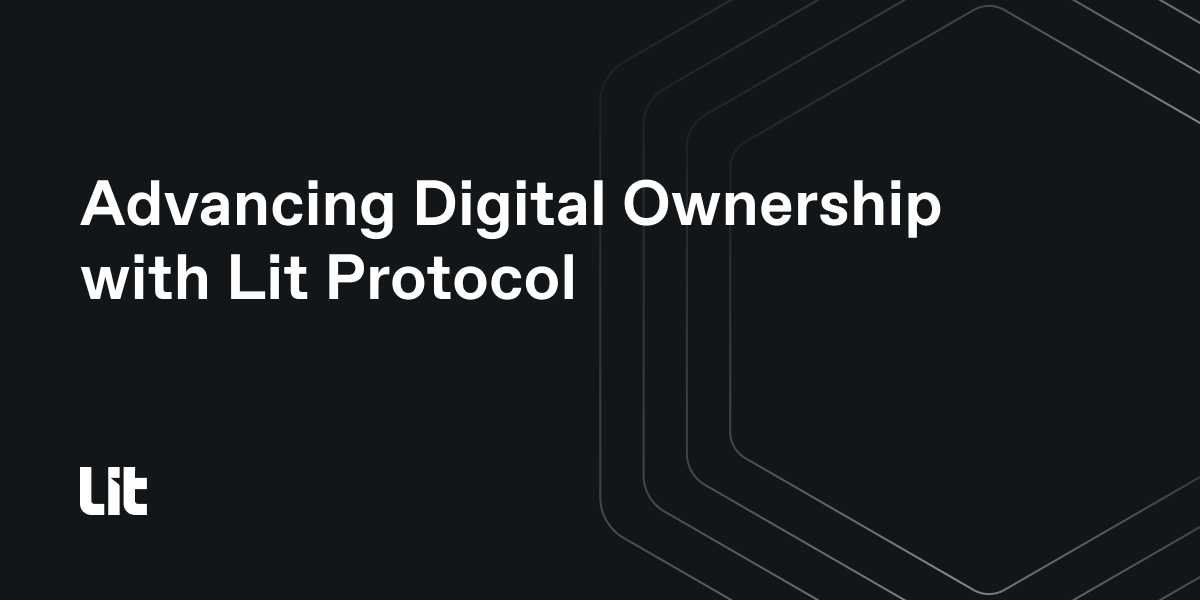Advancing Digital Ownership with Lit Protocol

Advancing Digital Ownership
5/21/24
At this moment in human history, we find ourselves in the midst of a technological revolution. There is an opportunity to break the oppressive systems of extraction that have long existed in traditional finance and now have fully extended into the internet.
Thoughtfully applied, digital ownership and AI are the tools to break free from these constraints and finally put individuals in control of their value.
Let’s explore the concept of digital ownership, the new problems of this epoch, and how Lit Protocol — a decentralized key management and compute network — and its partners are creating digital ownership solutions across Identity, Finance, Personal Data, Community, AI, and Web3 Infrastructure.
Digital Ownership & Open Privacy
Digital ownership consists of two critical components — signing and state. Satoshi Nakamoto, author of the Bitcoin whitepaper, understood this well when writing:
"Digital signatures provide part of the solution, but the main benefits are lost if a trusted third party is still required to prevent double-spending."
State represents the current status and properties of assets, like those stored on a blockchain. Digital signatures put the individual in control of these assets. These signatures are created with a cryptographic key and act like a secure digital stamp that proves authenticity and ownership. The synergy between signing and state is what enables digital assets to be free from extraction. Signing key management is a problem that Lit Protocol addresses, without requiring centralized custodians or other dependent vendors.
For data storage (aka, state) to be resilient, it must exist in the public domain so that it can be replicated for redundancy. This presents a unique problem for personal and proprietary data. For private data to exist on the open web, data must be encrypted to ensure only permitted parties have access.
Encryption and access control is a problem that Lit Protocol addresses — again, without requiring a centralized secret manager.
What's Lit?
Bitcoin was the first decentralized ledger — a revolutionary alternative to centralized authorities that censor and otherwise control how data is recorded, stored, and distributed. With Ethereum, Vitalik Buterin built upon Bitcoin’s revolutionary potential by making a decentralized ledger fully programmable with smart contracts.
When Lit v0 launched in March of 2024, Lit became the first decentralized and programmable key management infrastructure. When Lit v0.1 was released last week, this capacity was expanded even further.
Where blockchains removed the need to manage servers for state, Lit removes the burden on developers to manage keys and implement cryptography. Instead, Lit can be used as a platform to implement all of your cryptography needs, including signing, encryption, and performing immutable and private compute.
To offer this functionality, Lit uses a number of methods that include threshold signature schemes and sealed, confidential hardware. This helps to keep key material and compute decentralized, private, and in control of users — not with the Lit Protocol node operators nor developers.
Read more about how Lit Protocol works here:
Identity
In crypto and web3, keys are used to manage digital identity. Lit provides a base layer for wallet-as-a-service, where key material is managed by the Lit network.
The team at Obvious has integrated Lit to provide crypto domains + wallet onboarding to millions of users.
Finance
The programmable keys provided by the Lit network facilitate the execution of complex financial interactions and can immutably interface with DeFi smart contracts.
The team at Genius is building the ultimate and most efficient cross-chain DeFi tool with Lit.
Personal Data
Encrypting data with Lit and storing it on web3 storage gives users resilient and private data as well as the ability to selectively and programmably grant access, while allowing them to maintain data sovereignty.
The team at Terminal 3 has encrypted millions of personal data points with Lit.
Community
Communities are fundamental to digital ownership in the decentralized era. Today, Lit’s encryption is being used for everything from data unions to digital product NFTs. Signing is being used to power cross-chain group wallets.
The team at Collab.Land is using Lit to power their Telegram wallet and social app.
Web3 Infrastructure
As a generalized and fully programmable system, Lit is powering a variety of crypto infrastructure protocols, including data marketplaces, bridges, and private oracles.
The team at Fox Corp (BCL) is using Lit to power content licensing for their open data syndication protocol.
AI
Lit is being used to build community AIs, where data is encrypted with Lit and stored on the open web. This is followed by performing inference and training within Lit.
The team at Nesa is exploring Lit to build decentralized AI.
Looking Ahead
A pragmatic path lies ahead for technology to empower users and deliver greater individual freedoms. Our mission at Lit is to provide the tools that make this idealized vision for the future more attainable, making it easier and more obvious for developers to put users in control.
If you’d like to build with Lit, get started here or get in touch to learn more.
If you’re interested in joining the team, check out these open roles.
Thank you for reading. Onward to web3!

